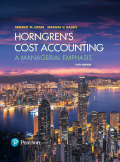Variable costing versus absorption costing. The Mavis Company uses an absorption-costing system based on standard costs. Total variable manufacturing cost, including direct material cost, is $3 per unit; the standard production rate is 10 units per machine-hour. Total budgeted and actual fixed manufacturing overhead costs are $420,000. Fixed manufacturing overhead is allocated at $7 per machinehour ($420,000, 60,000 machine-hours of denominator level). Selling price is $5 per unit. Variable operating (nonmanufacturing) cost, which is driven by units sold, is $2 per unit. Fixed operating (nonmanufacturing) costs are $240,000. Beginning inventory in 2014 is 30,000 units; ending inventory is 40,000 units. Sales in 2014 are 540,000 units. The same standard unit costs persisted throughout 2013 and 2014. For simplicity, assume that there are no price, spending, or efficiency variances. 1. Prepare an income statement for 2014 assuming that the production-volume variance is written off at year-end as an adjustment to cost of goods sold. 2. The president has heard about variable costing. She asks you to recast the 2014 statement as it would appear under variable costing. 3. Explain the difference in operating income as calculated in requirements 1 and 2. 4. Graph how fixed manufacturing overhead is accounted for under absorption costing. That is, there will be two lines: one for the budgeted fixed manufacturing overhead (which is equal to the actual fixed manufacturing overhead in this case) and one for the fixed manufacturing overhead allocated. Show the production-volume variance in the graph. 5. Critics have claimed that a widely used accounting system has led to undesirable buildups of inventory levels. (a) Is variable costing or absorption costing more likely to lead to such buildups? Why? (b) What can managers do to counteract undesirable inventory buildups?


 Managerial AccountingAccountingISBN:9781337912020Author:Carl Warren, Ph.d. Cma William B. TaylerPublisher:South-Western College Pub
Managerial AccountingAccountingISBN:9781337912020Author:Carl Warren, Ph.d. Cma William B. TaylerPublisher:South-Western College Pub Principles of Cost AccountingAccountingISBN:9781305087408Author:Edward J. Vanderbeck, Maria R. MitchellPublisher:Cengage Learning
Principles of Cost AccountingAccountingISBN:9781305087408Author:Edward J. Vanderbeck, Maria R. MitchellPublisher:Cengage Learning Financial And Managerial AccountingAccountingISBN:9781337902663Author:WARREN, Carl S.Publisher:Cengage Learning,
Financial And Managerial AccountingAccountingISBN:9781337902663Author:WARREN, Carl S.Publisher:Cengage Learning, Cornerstones of Cost Management (Cornerstones Ser...AccountingISBN:9781305970663Author:Don R. Hansen, Maryanne M. MowenPublisher:Cengage Learning
Cornerstones of Cost Management (Cornerstones Ser...AccountingISBN:9781305970663Author:Don R. Hansen, Maryanne M. MowenPublisher:Cengage Learning



